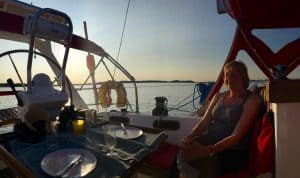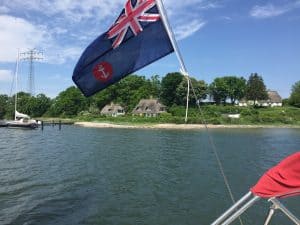 The final stretch of the Kiel canal from Rendsburg was another 3½ hours of motoring during which time we were overtaken by a succession of large ships, some of which towered over us with many storeys of containers. We came eventually to the locks at Holtenau. As the small locks are out of service at present, we had to tuck into a large lock with the big ships.
The final stretch of the Kiel canal from Rendsburg was another 3½ hours of motoring during which time we were overtaken by a succession of large ships, some of which towered over us with many storeys of containers. We came eventually to the locks at Holtenau. As the small locks are out of service at present, we had to tuck into a large lock with the big ships.
As the gates opened we finally entered the Baltic. It was very good to raise sail again after all that motoring, even though we had a beat against the wind up the Kieler Förde. Once clear of that we had a broad reach in a light wind and were able to set the jenniker, which gave us an extra turn of speed.  And so we came to the Schlei Fjord. We found ourselves a nice anchorage not far in and settled down for the night. The next day Friday we rested there the whole day in a lovely spot and fine gentle weather. We dozed, ate, read, swam and thoroughly enjoyed it.
And so we came to the Schlei Fjord. We found ourselves a nice anchorage not far in and settled down for the night. The next day Friday we rested there the whole day in a lovely spot and fine gentle weather. We dozed, ate, read, swam and thoroughly enjoyed it.
A few words about the Baltic sea and tides
The Baltic is, in effect, shut off from the tides of the great oceans. The lunar tide is negligible, being around 10cm although a bit more in places. This makes for a very different experience for those of us used to waters where the tide dominates everything. No longer do we need to plan passages to take account of the tides – no more 4:00am starts but rather we can leave ‘after coffee’ if a passage is not too long and still arrive in time for an aperitif before supper. Sailing here is, therefore, relatively straight forward and popular. Care is still needed. The waters are mostly shallow, there are rocks aplenty and shallow seas can develop steep short waves in a blow. We also need to look out for the changes in water level brought about by atmospheric conditions. Low pressure tends to raise the water level and high pressure depress it. Even more significantly, strong winds blow the water from one end of the Baltic to the other. In strong easterlies the water piles up at the western end, whilst in westerlies it gets blown to the east. The water level can rise three metres or more above mean level or drop two metres below. In shallow seas this can be very significant and if you run aground here, rather than waiting a maximum of just under 12 hours for the tide to float you off, you might be waiting weeks for the winds to reverse. All this water moving about creates currents. In tidal waters currents are predicted in relation to the hours before or after high water. Here they are predicted for various hours after certain wind changes. This is all very strange and different and will take getting used to.
The Schlei Fjord
After our rest we explored the Schlei Fjord. This stretch of water extends over 20nm (37km) inland to the ancient city of Schleswig.  There are a series of broad waters interconnected by narrows. The countryside is low rolling hills and there are many lovely old houses with thatched roofs along the water’s edge. Something feels a bit familiar about this, which is not surprising as we are in the old district of Angeln, from where the invaders of England originated, leading to the Anglo-Saxon kingdoms. Place names ending in -by abound e.g. Norby, Grumby, Senby and Haddeby, which remind us of English towns and villages like Grimsby, Spilsby and Hemsby.
There are a series of broad waters interconnected by narrows. The countryside is low rolling hills and there are many lovely old houses with thatched roofs along the water’s edge. Something feels a bit familiar about this, which is not surprising as we are in the old district of Angeln, from where the invaders of England originated, leading to the Anglo-Saxon kingdoms. Place names ending in -by abound e.g. Norby, Grumby, Senby and Haddeby, which remind us of English towns and villages like Grimsby, Spilsby and Hemsby.
There are many, many yachts in the Schlei Fjord as it is something of a sailing Mecca and holiday destination. There are over a dozen yacht havens and many minor jetties by inns or camp sites.
We had a good sail up the fjord and at one stage fell into the company of two other yachts and an informal race developed. We were neck and neck for an hour or so with first one and then the other gaining a small advantage. Had we still had our feathering propellor on we would have been able to steal ahead as it gives us nearly an extra knot in light conditions. The ‘race’ was brought to an end by arriving at a railway bridge which only opens at 15 minutes to the hour.
 We spent another night at anchor in the Grosse Breite before sailing to Schleswig itself to restock and do laundry tasks. Schleswig is a fine and ancient city – it claims to be the oldest in northern Europe, although we are unsure on what grounds. Its position at the head of the Schlei must have made it key in ancient times. We are berthed close to the old city itself, which is dominated by the cathedral or dom and there are fascinating streets. Many of the houses have very individual and ornate front doors.
We spent another night at anchor in the Grosse Breite before sailing to Schleswig itself to restock and do laundry tasks. Schleswig is a fine and ancient city – it claims to be the oldest in northern Europe, although we are unsure on what grounds. Its position at the head of the Schlei must have made it key in ancient times. We are berthed close to the old city itself, which is dominated by the cathedral or dom and there are fascinating streets. Many of the houses have very individual and ornate front doors.
We are expecting strongish winds from the east for many days, so are not sure how we will get out of the long fjord. More news when we do!
Ynskje & Tony x

How fascinating to hear about the currents as apposed to tides and about the changes in water level. Very interesting! Quite a different approach in dealing with similar problems. Good luck! All sounds lovely and different.
Love to you both. Liz